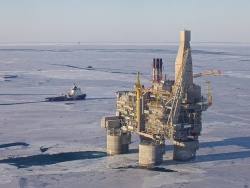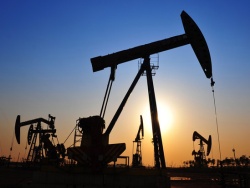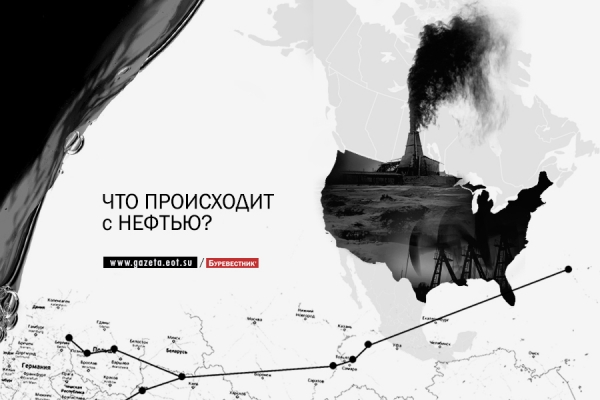
Improving the efficiency of shale extraction expands the opportunities for long-term planning, but will gradually shift the price range down. This means that in the foreseeable future will not be economic sense to develop expensive projects or the Arctic shelf of Eastern Siberia and should focus on improving the efficiency of existing fields and the competitive structure of the industry
To predict the price of oil – economic mauvais ton. About the price of oil it is only known that it is impossible to predict. But we have some figures to insert in the budget or investment projects, and analysts continue to draw a smooth line upward from the current price.
World oil demand is slightly more than 95 million barrels, increasing by only 1-2% per year. Global imbalances (deficit or surplus), rarely exceeds 2 million barrels, that is, less than 2%. Most industries never dreamed of such stability and market balance. Where did the oil market, the continuous price storm and if he could subside in the foreseeable future?
Three amplifier
The first factor is market size. In a big ocean – big waves. The oil market is global and has no barriers. The price for all participants is determined by the demand and supply of the marginal barrel, that is, those two percent of surplus or deficit and the burden of financial derivatives, increasing the amplitude of oscillations.
The second factor is the oil consumption − does not react to the increase or decrease of prices, due to high value and lack of good substitutes. Oil remains the best source of energy for transport and unique raw material for the chemical industry. The experience of Germany and Japan during the Second world war showed how risky do not have their own sources of oil, the primary fuel of the army, Navy and air force. As a result, consumers have formed particularly sensitive to oil. Unlike traditional markets, the price increase does not reduce demand, but rather enhances the excitement and anxiety of consumers. As shown by the summer of 2008, even $140 per barrel are not a sufficient incentive to reduce consumption.
The third factor – the structure of the sentence. At first glance, the market is competitive: many manufacturers, and the largest, Saudi Arabia, controlled only 11% of production. However, the middle East accounts for more than half of oil reserves, and the cost is only a few dollars per barrel. It is possible to create a successful cartel to influence the oil price by restricting output. In this competition, the cost of which is several times higher risk to be constantly in a situation of sudden dumping.
In a global world free from the geopolitics, all necessary mankind oil could be produced in the Persian Gulf, saving more than a trillion dollars a year. In practice, the middle East accounts for only about a quarter of world production.
Look at the supply of oil outside OPEC and how it reacts to price change. Short-term supply is determined by costs on the rise, that is, the cost of maintaining production at a field. Long-term supply – full cost, taking into account capital expenditure for field development from scratch.
Costs rise most manufacturers are only $10-20 per barrel. Only for the most difficult deposits such as canadian oil Sands, they can exceed $30. Therefore, manufacturers try to keep the maximum level of production in undeveloped fields, and by reducing the price down to the $20-30 they are not advisable to reduce the volume. Moreover, many of the exporting countries, with the fall in oil prices worsens the trade balance, and depreciates the national currency. The result is reduced cost, increasing the incentive to export even more oil.
The total cost is significantly higher, ranging from $40 to $90 per barrel. The volume of investments into one project – from the hundreds of millions for smaller fields up to tens of billions of dollars for major offshore projects. The development of new deposits is from 3 to 10 years. That is, the investor must believe that the long-term price of oil will substantially exceed the full cost of the project.
The oil market works as a good amplifier. Any change in demand or supply in the form of marketing wave. The wave continues to grow, without encountering significant resistance. The offer starts to react only at $10-15 from below, when the price is below the current costs and begins reducing production at existing fields, and $100-120 dollars extra when there is a sufficient incentive to invest in new projects. The market takes years to adjust the volume up or down while gradually decreasing production from existing fields, or you receive a new oil projects.
Shale stabilizer
The collapse in oil prices of the past two years fits into this logic. After 20 years of deficit several overlapping events have led to a significant oversupply: restoring production in Iraq, the lifting of the embargo with Iran, the oil boom in the United States and the slowdown of China’s economy. One of these events not only affected the current situation, but also radically changed the market structure and the effects comparable to the dismemberment of Standard Oil or the formation of OPEC.
Talking about shale oil. From 2011 to 2015 the mining of shale deposits in the United States increased by 4 million barrels a day. This is a relatively expensive oil. The total cost ranges from $40 to $70 per barrel, but costs are steadily falling under the influence of competition and technological innovation. From 2007 to 2014, the capacity of one rig in terms of ton of oil produced increased by 30% annually.
Developed infrastructure and efficient financial market is radically shorten the investment cycle of shale oil. From decision-making before the advent of oil in the market, takes several months and sometimes weeks. Minimum project size – one well, that is several million dollars. The extraction of shale deposits is not only growing rapidly, but decreases rapidly in the absence of investment. The typical debit of the well is reduced by 75% within the first year of operation.
Thus, the most important difference of us shale oil has become the rate at which the volume of production responds to the growth and price reduction: just a few months, not years, as traditional fields.
At a price of above $60-70 mobilized the maximum number of drilling rigs, extraction rapidly increasing. If the price declines below $60 the number of rigs decreases, and the volume of production is adjusted to the natural fall of the debits, even without preserving the existing wells. Thus, under the impact of lower prices by March 2016 the volume of production has decreased by 0.6 million barrels, compared with a maximum summer of 2015. The market sees not only the decline, but the decline in drilling activity, that is, can take into account the expected decline in the future. It dynamics on the oil shale deposits of the United States is due to the rebound from $30 to $40 in the first quarter of 2016, instead of falling to the levels of $10-20.
Shale oil also reduces the possibility of OPEC. The attempt of OPEC to cut production volume will lead to higher prices, shale companies will quickly occupy the vacated niche, and the price will return to previous levels. Dumping by OPEC will lead to a drop in prices and perhaps even to mass bankruptcies of shale producers, but will not reduce the potential of American shale deposits. Once stabiliziruemost prices, shale assets will be quickly put into production.
Proved reserves of shale oil in the US, about 50 billion barrels, which will produce 3-5 million barrels a day within 20-30 years. While technology in this competitive market will continue to improve, reducing costs and increasing recoverable reserves. On the global oil market appeared efficient absorber of price fluctuations, up to 5% of the market, and it is several times more than the typical amount of imbalance.
Planned and inexpensive
What does it mean for Russia? The price of $30-40, which we have seen since the beginning of the year, held amid continuing oversupply. In the future, year and a half growing demand will overtake supply and the price will inevitably rise, if no new shocks such as the beginning of a recession in China or the United States.
Marginal barrel determining the global price of oil, now is shale oil, which change prices quickly responds with a volume change. Therefore, the amplitude of fluctuations in oil prices will decrease from $10-140, which we watched from the late 70-ies, to $30-70, due to the cost of shale oil.
Lower volatility in oil prices, perhaps, good news for the country, with a budget of more than half dependent on oil revenues. It is possible to more meaningful planning at the state, business and even ordinary citizens. However, continuous increase of efficiency of shale production will gradually shift the price range down. This means that in the foreseeable future will not be economic sense to develop expensive projects or the Arctic shelf of Eastern Siberia and should focus on improving the efficiency of existing fields and the competitive structure of the industry.
New price rally will not happen even in case of an insufficient volume to 1-2 million barrels a day, which in itself is unlikely. To knock the market from state controlled shale oil, and to go beyond the corridor in the $30-70, you will need more powerful pulses than a conventional shock in demand or supply: a large-scale war in the Gulf, a breakthrough in the efficiency of electric batteries or conflict between China and America. From which, however, no one is immune.








